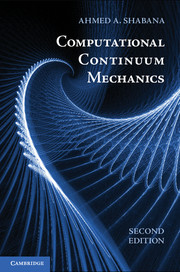Book contents
- Frontmatter
- Contents
- Preface
- 1 Introduction
- 2 Kinematics
- 3 Forces and Stresses
- 4 Constitutive Equations
- 5 Plasticity Formulations
- 6 Finite Element Formulation: Large-Deformation, Large-Rotation Problem
- 7 Finite Element Formulation: Small-Deformation, Large-Rotation Problem
- 8 Computational Geometry and Finite Element Analysis
- References
- Index
7 - Finite Element Formulation: Small-Deformation, Large-Rotation Problem
Published online by Cambridge University Press: 05 June 2012
- Frontmatter
- Contents
- Preface
- 1 Introduction
- 2 Kinematics
- 3 Forces and Stresses
- 4 Constitutive Equations
- 5 Plasticity Formulations
- 6 Finite Element Formulation: Large-Deformation, Large-Rotation Problem
- 7 Finite Element Formulation: Small-Deformation, Large-Rotation Problem
- 8 Computational Geometry and Finite Element Analysis
- References
- Index
Summary
In the preceding chapter, a nonlinear finite element formulation for the large-deformation analysis was presented. This formulation, which is consistent with the motion description used in the theory of continuum mechanics and can be used to correctly describe an arbitrary rigid-body motion, leads to a constant mass matrix and nonlinear vector of elastic forces. The formulation imposes no restrictions on the amount of rotation or deformation within the element, except for the restriction imposed by the order of the interpolating polynomials used. In large-deformation problems, in general, the shape of deformation of the bodies can be complex and this, in turn, necessitates the use of a large number of finite element nodal coordinates in order to be able to correctly capture the geometry of deformation. Therefore, in the analysis of the large-deformation problem using the absolute nodal coordinate formulation discussed in the preceding chapter, one simply selects an adequate number of finite elements and formulates the equations of motion in terms of the element nodal coordinates. There is no need to introduce another reference frame or be concerned with the use of coordinate reduction techniques. The results published in the literature on the absolute nodal coordinate formulation demonstrated that this formulation can be used in modeling very large deformations with relatively small number of finite elements compared to other existing nonlinear finite element formulations.
The use of a full finite element representation to study small-deformation problems is not recommended because such a representation is not the most efficient approach to solve for the small deformations. The geometry of the small deformation of the bodies takes simple forms, and one in this case can develop a lower-dimension model that can be efficiently used to solve this class of problems. Furthermore, in the analysis of small deformations, with a proper selection of the coordinate systems, one can use finite elements, which have smaller number of nodal coordinates. For example, conventional nonisoparametric beam, plate, and shell finite elements, which cannot correctly describe arbitrary rigid-body motion using the element nodal coordinates, can still be used in small-deformation large-displacement formulations. By defining a local linear elasticity problem, linear modes can also be used to further reduce the number of the model degrees of freedom and eliminate high-frequency modes of vibration. The approach that is most widely used to solve the small-deformation, large-rotation problem is called the floating frame of reference formulation. The finite element floating frame of reference formulation, which is discussed in this chapter, was introduced in the early eighties (Shabana and Wehage, 1981; Shabana, 1982) and was the basis for developing new computational algorithms that led to introducing new generation of codes that became known as flexible multibody computer codes, which are widely used in industry, universities, and research institutions.
- Type
- Chapter
- Information
- Computational Continuum Mechanics , pp. 262 - 295Publisher: Cambridge University PressPrint publication year: 2011

